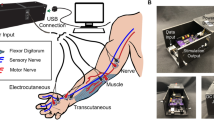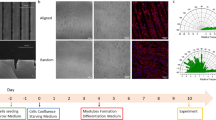Abstract
A drawback of electrical stimulation for muscle control is that large, fatigable motor units are preferentially recruited before smaller motor units by the lowest-intensity electrical cuff stimulation. This phenomenon limits therapeutic applications because it is precisely the opposite of the normal physiological (orderly) recruitment pattern; therefore, a mechanism to achieve orderly recruitment has been a long-sought goal in physiology, medicine and engineering. Here we demonstrate a technology for reliable orderly recruitment in vivo. We find that under optical control with microbial opsins, recruitment of motor units proceeds in the physiological recruitment sequence, as indicated by multiple independent measures of motor unit recruitment including conduction latency, contraction and relaxation times, stimulation threshold and fatigue. As a result, we observed enhanced performance and reduced fatigue in vivo. These findings point to an unanticipated new modality of neural control with broad implications for nervous system and neuromuscular physiology, disease research and therapeutic innovation.
This is a preview of subscription content, access via your institution
Access options
Subscribe to this journal
Receive 12 print issues and online access
$209.00 per year
only $17.42 per issue
Buy this article
- Purchase on Springer Link
- Instant access to full article PDF
Prices may be subject to local taxes which are calculated during checkout




Similar content being viewed by others
References
Burke, R.E., Levine, D.N., Tsairis, P. & Zajac, F.E. III. Physiological types and histochemical profiles in motor units of the cat gastrocnemius. J. Physiol. (Lond.) 234, 723–748 (1973).
Henneman, E. Relation between size of neurons and their susceptibility to discharge. Science 126, 1345–1347 (1957).
Henneman, E., Somjen, G. & Carpenter, D.O. Functional significance of cell size in spinal motoneurons. J. Neurophysiol. 28, 560–580 (1965).
Gordon, T., Thomas, C.K., Munson, J.B. & Stein, R.B. The resilience of the size principle in the organization of motor unit properties in normal and reinnervated adult skeletal muscles. Can. J. Physiol. Pharmacol. 82, 645–661 (2004).
Mendell, L.M. The size principle: a rule describing the recruitment of motoneurons. J. Neurophysiol. 93, 3024–3026 (2005).
Bakels, R. & Kernell, D. Matching between motoneurone and muscle unit properties in rat medial gastrocnemius. J. Physiol. (Lond.) 463, 307–324 (1993).
Singh, K., Richmond, F.J. & Loeb, G.E. Recruitment properties of intramuscular and nerve-trunk stimulating electrodes. IEEE Trans. Rehabil. Eng. 8, 276–285 (2000).
Fang, Z.P. & Mortimer, J.T. Selective activation of small motor axons by quasi-trapezoidal current pulses. IEEE Trans. Biomed. Eng. 38, 168–174 (1991).
Lertmanorat, Z. & Durand, D.M. Extracellular voltage profile for reversing the recruitment order of peripheral nerve stimulation: a simulation study. J. Neural Eng. 1, 202–211 (2004).
Hamada, T., Kimura, T. & Moritani, T. Selective fatigue of fast motor units after electrically elicited muscle contractions. J. Electromyogr. Kinesiol. 14, 531–538 (2004).
Zhang, F., Aravanis, A.M., Adamantidis, A., de Lecea, L. & Deisseroth, K. Circuit-breakers: optical technologies for probing neural signals and systems. Nat. Rev. Neurosci. 8, 577–581 (2007).
Boyden, E.S., Zhang, F., Bamberg, E., Nagel, G. & Deisseroth, K. Millisecond-timescale, genetically targeted optical control of neural activity. Nat. Neurosci. 8, 1263–1268 (2005).
Wang, H. et al. High-speed mapping of synaptic connectivity using photostimulation in channelrhodopsin-2 transgenic mice. Proc. Natl. Acad. Sci. USA 104, 8143–8148 (2007).
Rasband, M.N. & Trimmer, J.S. Developmental clustering of ion channels at and near the node of Ranvier. Dev. Biol. 236, 5–16 (2001).
Zajac, F.E. & Faden, J.S. Relationship among recruitment order, axonal conduction velocity and muscle-unit properties of type-identified motor units in cat plantaris muscle. J. Neurophysiol. 53, 1303–1322 (1985).
Fuglevand, A.J., Winter, D.A. & Patla, A.E. Models of recruitment and rate coding organization in motor-unit pools. J. Neurophysiol. 70, 2470–2488 (1993).
Kan, H.E. et al. Lower force and impaired performance during high-intensity electrical stimulation in skeletal muscle of GAMT-deficient knockout mice. Am. J. Physiol. Cell Physiol. 289, C113–C119 (2005).
Zhan, W.Z. et al. Effects of genetic selection and voluntary activity on the medial gastrocnemius muscle in house mice. J. Appl. Physiol. 87, 2326–2333 (1999).
McPhedran, A.M., Wuerker, R.B. & Henneman, E. Properties of motor units in a heterogeneous pale muscle (m. gastrocnemius) of the cat. J. Neurophysiol. 28, 85–99 (1965).
Burkholder, T.J., Fingado, B., Baron, S. & Lieber, R.L. Relationship between muscle fiber types and sizes and muscle architectural properties in the mouse hindlimb. J. Morphol. 221, 177–190 (1994).
Cope, T.C. & Clark, B.D. Motor-unit recruitment in the decerebrate cat: several unit properties are equally good predictors of order. J. Neurophysiol. 66, 1127–1138 (1991).
Milner-Brown, H.S., Stein, R.B. & Yemm, R. The orderly recruitment of human motor units during voluntary isometric contractions. J. Physiol. (Lond.) 230, 359–370 (1973).
Allen, D.G. & Westerblad, H. The effects of caffeine on intracellular calcium, force and the rate of relaxation of mouse skeletal muscle. J. Physiol. (Lond.) 487, 331–342 (1995).
al-Amood, W.S., Lewis, D.M. & Schmalbruch, H. Effects of chronic electrical stimulation on contractile properties of long-term denervated rat skeletal muscle. J. Physiol. (Lond.) 441, 243–256 (1991).
Burke, R.E., Levine, D.N. & Zajac, F.E. Mammalian motor units: physiological-histochemical correlation in three types in cat gastrocnemius. Science 174, 709–712 (1971).
Sokoloff, A.J., Siegel, S.G. & Cope, T.C. Recruitment order among motoneurons from different motor nuclei. J. Neurophysiol. 81, 2485–2492 (1999).
Hayashi, A. et al. Retrograde labeling in peripheral nerve research: it is not all black and white. J. Reconstr. Microsurg. 23, 381–389 (2007).
Thrasher, A., Graham, G.M. & Popovic, M.R. Reducing muscle fatigue due to functional electrical stimulation using random modulation of stimulation parameters. Artif. Organs 29, 453–458 (2005).
Fang, Z.P. & Mortimer, J.T. A method to effect physiological recruitment order in electrically activated muscle. IEEE Trans. Biomed. Eng. 38, 175–179 (1991).
Zhou, B.H., Baratta, R. & Solomonow, M. Manipulation of muscle force with various firing rate and recruitment control strategies. IEEE Trans. Biomed. Eng. 34, 128–139 (1987).
Zhang, F. et al. Red-shifted optogenetic excitation: a tool for fast neural control derived from Volvox carteri. Nat. Neurosci. 11, 631–633 (2008).
Berndt, A., Yizhar, O., Gunaydin, L.A., Hegemann, P. & Deisseroth, K. Bi-stable neural state switches. Nat. Neurosci. 12, 229–234 (2009).
Bainbridge, J.W. et al. Effect of gene therapy on visual function in Leber's congenital amaurosis. N. Engl. J. Med. 358, 2231–2239 (2008).
Maguire, A.M. et al. Safety and efficacy of gene transfer for Leber's congenital amaurosis. N. Engl. J. Med. 358, 2240–2248 (2008).
McClelland, S., Teng, Q., Benson, L.S. & Boulis, N.M. Motor neuron inhibition–based gene therapy for spasticity. Am. J. Phys. Med. Rehabil. 86, 412–421 (2007).
Gradinaru, V. et al. Molecular and cellular approaches for diversifying and extending optogenetics. Cell 141, 154–165 (2010).
Irintchev, A., Draguhn, A. & Wernig, A. Reinnervation and recovery of mouse soleus muscle after long-term denervation. Neuroscience 39, 231–243 (1990).
McHanwell, S. & Biscoe, T.J. The sizes of motoneurons supplying hindlimb muscles in the mouse. Proc. R. Soc. Lond. B Biol. Sci. 213, 201–216 (1981).
Acknowledgements
We thank R. Barretto and D. Wetmore for technical assistance and K. McGill, Z. Lateva, R. Lieber, D. Lin and F. Zajac for fruitful discussions. This work was supported by a Stanford Bio-X Interdisciplinary Initiatives award (S.L.D. and K.D.), the National Alliance for Research on Schizophrenia and Depression (K.R.T.), and the Stanford–US National Institutes of Health Medical Scientist Training Program (M.E.L.).
Author information
Authors and Affiliations
Contributions
M.E.L. conducted the experiments, performed the analysis and wrote the manuscript. K.R.T. performed the imaging experiments and wrote the manuscript. S.L.D. and K.D. supervised the project and wrote the manuscript.
Corresponding authors
Ethics declarations
Competing interests
The authors declare no competing financial interests.
Supplementary information
Supplementary Text and Figures
Supplementary Figure 1 and Supplementary Methods (PDF 435 kb)
Rights and permissions
About this article
Cite this article
Llewellyn, M., Thompson, K., Deisseroth, K. et al. Orderly recruitment of motor units under optical control in vivo. Nat Med 16, 1161–1165 (2010). https://doi.org/10.1038/nm.2228
Received:
Accepted:
Published:
Issue Date:
DOI: https://doi.org/10.1038/nm.2228
This article is cited by
-
Neuronal and synaptic adaptations underlying the benefits of deep brain stimulation for Parkinson's disease
Translational Neurodegeneration (2023)
-
Optical and pharmacological manipulation of hypoglossal motor nucleus identifies differential effects of taltirelin on sleeping tonic motor activity and responsiveness
Scientific Reports (2023)
-
Disentangling glial diversity in peripheral nerves at single-nuclei resolution
Nature Neuroscience (2022)
-
Sensory feedback for limb prostheses in amputees
Nature Materials (2021)
-
Interfaces with the peripheral nervous system for the control of a neuroprosthetic limb: a review
Journal of NeuroEngineering and Rehabilitation (2020)



